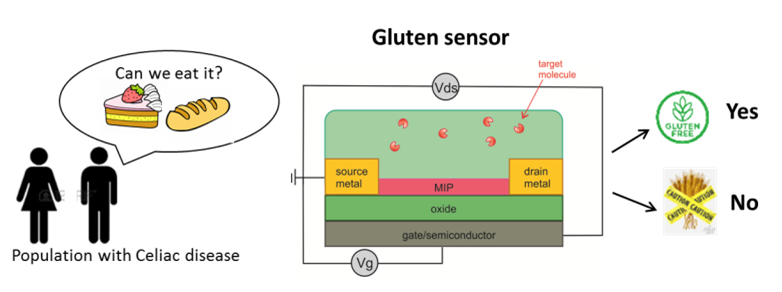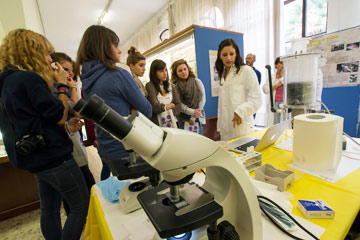The GEMS project aims at the development of a portable sensor for the determination of gluten allergens in food.
The project and its importance for the society: Celiac disease affect the 1-2% of the European population, with estimate direct costs on the public health of about 3 billion euro/year. Just in the sole Italy, celiac disease is diagnosed with a frequency of 1 person every 100, with prevalence in female subjects. The term "celiac disease" indicates a permanent intolerance to the gluten by the immune system. In celiac suffering subjects gluten intake triggers autoimmune reactions with inflammation of the intestinal mucosa that leads to the atrophy of the intestinal villi and to chronic impairing conditions. There are no known medical treatments effective to cure the disease, but the therapy just is a strict gluten-free diet for life.
Given the fact that there is no medical treatment for celiac suffering subjects, having an autonomous, portable measurement methods designed specifically to alert those suffering from celiac sprue that the food is gluten-free, responds to the need to offer food safety perspectives to those suffering from this chronic disease.
The aim of the project is to devise a chemical sensor for fast point of care testing of gluten content in food, by the design of a portable sensor based on a polymer recognition unit, thanks to molecular-type polymer (MIP) technology, and to an electrochemical transducer, as shown in the Figure below.
 Objectives:
Objectives:
- performing in silico digestion of gluten proteins to identify toxic peptides of gluten, using biochemical and biological-databases. Focus is on those epitopes that are reported as harmful for patients suffering from celiac disease.
- selection of functional monomers containing sites capable of forming complexes with the gluten epitope templates and suitable for electrochemical polymerization.
- imprinting of the toxic gluten epitopes directly on the surfaces of the chosen transduction structures, the characterization of the MIP films by surface investigating techniques, template removal from the MIP networks.
- validating the fabricated chemical sensor; checking its selective response to the gluten epitope both with model samples and with real samples. For a comparison commercially available ELISA gluten kits will be utilized.
Outcomes of the project, so far.
The design elements of MIP recognition, able to recognize and bind specific peptide sequences (epitopes) of proteins mainly involved in activating autoimmune reactions in people with celiac disease, has been achieved by means of in silico search in the protein databases of toxic, allergenic, gluten peptide sequences. Immunogenic epitopes were selected to play the role of templates for imprinting. Investigated epitopes were: PQQPFPQQ (8-mer), PFPQPQLPY (9-mer), PQPQLPYPQ (9-mer), and PYPQPQLPY (9-mer). These sequences have been used as templates in the further step of preparing the MIP recognition elements.
The MIP composition has been optimized by quantum-chemical computation, so to define the type of monomer to form stable interaction with the peptide epitopes and the stechiometry to be used in the polymerization. Both functional monomers and cross-linking monomers were chosen from the existing 'library' of monomers based on the bis(2,2’-bithienyl)methane derivatives. Quantum-chemistry calculations were performed in order to optimize the structures of the complexes between the gluten epitope templates and the functional monomers. The most stable complexes were selected for the polymerization.
The imprinting with the toxic gluten epitope (PQQPFPQQ) was performed by electrodeposition directly on the surfaces of chosen transduction structures, Pt electrodes and Au-glass extended gates of field effect transistors (EG-FETs). The characterization of the MIP films by surface investigating techniques, such as AFM, XPS, PM-IRRAS was then performed. Procedures for template removal from the MIP networks were investigated and optimized.
With focus on the sensor performance, both the peptide template and peptide interferents with aminoacid substituents or fully non-related sequences of peptides were tested for their response on the gluten sensor, finally entire gluten proteins as well as gluten extracts from semola, from rice, from whey were also tested. The selectivity of the gluten sensor was proven even to the level of discrimitating the single aminoacid substitution respect to the template sequence. The sensitivity of the gluten sensor was within the range required by actual regulations. The validation of the fabricated chemical sensor included checking its selective response to the gluten epitope both towards the model samples and to the real samples. Model samples involved the digestion of gluten in pepsin, and the separation of the peptides into fractions (HPLC fingerprinting). All the fractions were tested with EG-FETs. For a comparison commercially available ELISA gluten kits were utilized. ELISA and gluten sensor data were in correlation showing the gluten sensor so far responded with adequate selectivity and with the sensitivity required by actual regulations of allergen free foods.
Societal challenges considerations: Devising a portable chemical sensor based on MIP for gluten allerges is an example of transfer of scientific efforts to the help of common daily life at the advantages of citizens that suffer from chronic celiac disease. The successes gained so far, in terms of selectivity and sensitivity of the sensor, makes its translation into a portable point of care device feasible in the timeline of more two-three years, in which the analytical chemistry research shall find a common language with the engineers so to improve the technical design of the gluten sensor and get to the stage of pilot commercial product. The researched are confident that the outcomes of the GEMS project will have a beneficial impact on the European markets for in-home smart-sensors for allergens.
The Fellow: Zofia Iskierko is the Marie Curie Fellow awarded of the GEMS project. She is expert in designing and developing chemical sensors based on molecularly imprinted polymers (MIPs) as recognition units for selective detection and determination of compounds of health importance. She studied chemistry in Poland at Military Academy of Technology in Warsaw and at the Maria Curie-Skłodowska University in Lublin, lately she got her PhD from the Institute of Physical Chemistry of Polish Academy of Sciences in Warsaw. Under the Marie Curie Fellowship she has been engaging in developing a novel chemosensor capable of gluten detection if food samples.
For an interview with Dr. Zofia Iskierko look at:
https://www.youtube.com/watch?v=3I7FORx3UpM&index=12&list=PL4U4LydJPmo0chlJGlBBR3UxHP7P-cnVB









